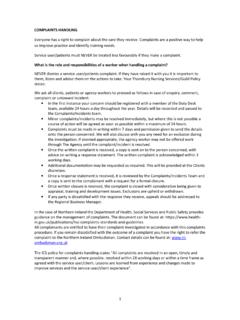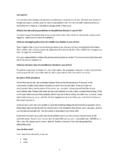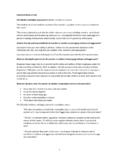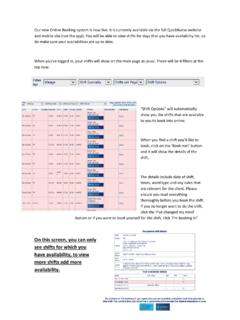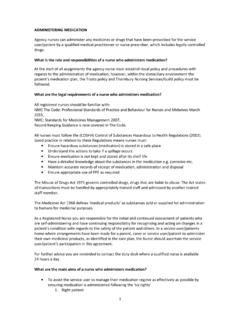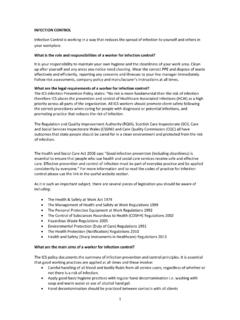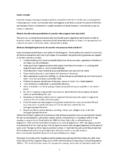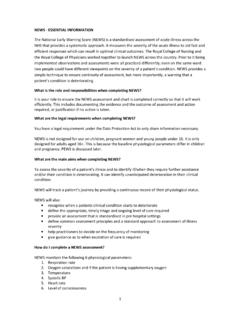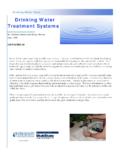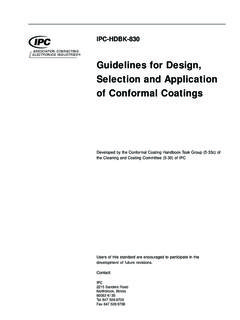Transcription of First Aid 2016 v2 - Thornbury Quick Nurse
1 1 First AID First Aid is the initial help given to a person who has suddenly suffered an injury or become ill. What is the role and responsibilities of a First aider ? To know your abilities and limitations To assess the situation, checking for any danger Protecting yourself firstly, then others from further danger remember you are no good as a First aider if you become injured yourself. To give emergency treatment with the assistance of those around you To minimise the risk of infection to yourself and the casualty To contact the emergency services when required Stay with the casualty until emergency services arrive and pass on as much relevant information as possible Responsible for First -aid equipment what is available, where and its maintenance Understand the legal requirements of the First aider To be aware of your own needs What are the legal requirements of a First aider ?
2 First aiders must have a valid certificate of competence First Aiders must re-qualify every three years There are two available regulated courses: the three-day First Aid at Work (FAW) course a one-day Emergency First Aid at Work (EFAW) course What are the main aims of a First aider ? To preserve life Prevent cross infection To prevent the condition getting any worse To comfort and reassure the casualty To promote the recovery of the casualty Minimising the risk of infection Infection is caused by pathogenic micro-organisms: bacteria viruses Routes of entry are: breathing in swallowing via blood and body fluids How can you minimise the risk of infection?
3 Wash hands using the correct hand washing technique (see hand washing below) after every task and in between changing gloves use disposable gloves and change them between tasks cover any breaks in skin cuts and grazes 2 remove any sharp objects that may cause an injury to yourself or others rings, broken glass etc. PLEASE NOTE NEVER REMOVE A SHARP OBJECT THAT IS EMBEDDED IN A CASUALTIES WOUND/BODY/SKIN dispose of contaminated waste safely by putting into a yellow clinical waste bag when available or double bag in household rubbish if in community.
4 Get medical advice about tetanus vaccination Hand washing Technique: wet hands using warm but not hot running water use approx a teaspoon of liquid soap in your palm and work into a lather rub the palm of your hand against the back of your other hand pushing your fingers in-between one another, repeat for other hand interlock your fingers to get the lather right in-between the fingers rub the tips of your fingers in your opposite palm, and repeat for the other hand cover your thumbs with your palm and rub the lather into your wrists remember if you are wearing a wedding ring to wash underneath and around this too swill off the lather under a running tap dry with disposable paper towels turn of the tap using either your elbows or the paper towels Establishing consent Before administering ANY First aid you must ask for consent.
5 Seek the casualty s consent before administering First aid REMEMBER the casualty has the right to refuse treatment explain what you are going to do and why and, before doing it, check that this is OK for an unconscious casualty, always talk through what you are doing when administering First aid. The last sense to go is your hearing, so the casualty may be reassured by you talking to them if they do not respond. First -aid incident report As a First aider it is your responsibility to ensure that incidents are reported as soon as is practical after the event.
6 Reports will usually contain details of: casualty s name, address and occupation date, time and place of incident what happened? injury or illness treatment given and action taken First aider name, signature and date entry made Calling 999 or 112 Before you call the emergency services gather as much information as possible to help them to help you. Information you will need includes: which service you require? Ambulance, Fire Service, Police, Coastguard the exact location of the casualty/casualties your telephone number type and severity of the incident number of casualties 3 name, gender and age of the casualty/casualties what happened?
7 How long ago? current condition of casualties (starting with the most serious casualty) any directions or arrangements to meet the ambulance. If possible have a dedicated person to look out for the ambulance and direct them into the casualty/casualties knowledge of any pre-existing conditions (heart problems, asthma, diabetes, epilepsy) details of any hazards electricity, gas, icy and foggy conditions, hazardous substances etc Remember to stay calm, speak clearly, stay on the line, answer all the questions you are asked. The operator will guide you through what you need to do.
8 Levels of consciousness How can you determine a casualty s level of consciousness? It can be determined using the AVPU code: Is the casualty ALERT and responding to you? Does the casualty respond to your VOICE? Can the casualty respond to your instructions appropriately? Can the casualty use his/her voice to speak to you even if confused? Does the casualty feel PAIN (shake the shoulders gently, unless you suspect a spinal injury) or does the casualty react when you touch him/her? The casualty has not responded to any of the above, therefore, must be UNCONSCIOUS.
9 Recovery Position If a person is unconscious but is breathing and has no other life-threatening conditions, they should be placed in the recovery position. The recovery position will ensure their airway remains clear and open. It also ensures that any vomit or fluid will drain away naturally and not cause them to choke. To place someone in the recovery position: kneel on the floor beside the casualty remove spectacles and any other bulky objects from pockets if possible make sure the casualty s legs are straight place the arm nearest you at a right angle to their body with their elbow bent and hand upwards towards the head bring their other hand over to the cheek closest to you so that the back of their hand is touching their cheek, hold in place with your other hand, bend the knee farthest from you to a right angle using the knee as a lever.
10 Roll the person onto their side carefully open the airway by gently tilting the casualties head and chin back, adjust the hand to keep airway open check they are breathing and that nothing is blocking their airway stay with the person and monitor their breathing until help arrives If assistance has not arrived in 30 minutes and if their injuries allow you to, turn the person onto their other side 4 Follow this link to watch the video on NHS Choices website: Bleeding Types of bleeding injury 1. Abrasion (graze) 2. Incision wound 3. Laceration 4.
